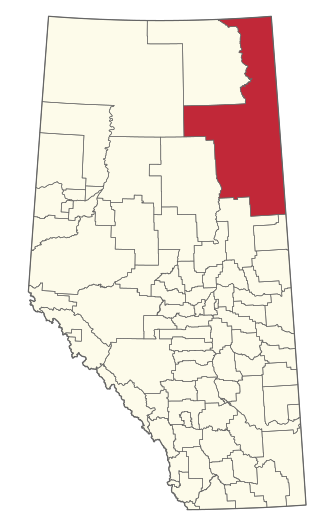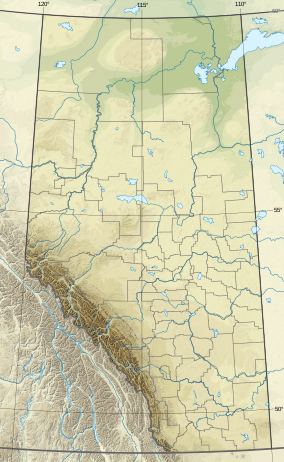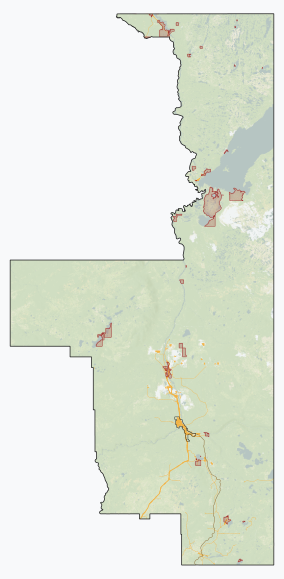
The Athabasca River is a river in Alberta, Canada, which originates at the Columbia Icefield in Jasper National Park and flows more than 1,231 km (765 mi) before emptying into Lake Athabasca. Much of the land along its banks is protected in national and provincial parks, and the river is designated a Canadian Heritage River for its historical and cultural importance. The scenic Athabasca Falls is located about 30 km (19 mi) upstream from Jasper.

The Regional Municipality of Wood Buffalo is a specialized municipality in northeast Alberta, Canada. It is the largest municipality in North America by area and is home to oil sand deposits known as the Athabasca oil sands.

Alberta Provincial Highway No. 63, commonly referred to as Highway 63, is a 434-kilometre (270 mi) highway in northern Alberta, Canada that connects the Athabasca oil sands and Fort McMurray to Edmonton via Highway 28. It begins as a two-lane road near the hamlet of Radway where it splits from Highway 28, running north through aspen parkland and farmland of north central Alberta. North of Boyle, it curves east to pass through the hamlet of Grassland and becomes divided west of Atmore where it again turns north, this time through heavy boreal forest and muskeg, particularly beyond Wandering River. Traffic levels significantly increase as Highway 63 bends through Fort McMurray, crossing the Athabasca River before connecting the city to the Syncrude and Suncor Energy plants further north. It ends approximately 16 km (10 mi) beyond a second crossing of the Athabasca River northeast of Fort McKay.

Northern Alberta is a geographic region located in the Canadian province of Alberta.
Birch Mountains Wildland Provincial Park is a wildland provincial park in northern Alberta, Canada. The park was established on 20 December 2000 with an area of 144,505 hectares. On 14 May 2018, the park was enlarged slightly to an area of 145,969 hectares. The park is contained in the Lower Athabasca Region Land Use Framework finalized in 2012. It contains a free roaming wood bison herd. The park is named for the Birch Mountains that are partially contained within the boundaries of the park.
Alberta Provincial Highway No. 686, also known as Highway 686, is an east–west highway in northern Alberta, Canada. It has two sections; the main section is a gravel highway that spans approximately 90 kilometres (56 mi) from Highway 88 near Red Earth Creek to Trout Lake, and a two-kilometre-long (1.2 mi) developing freeway section in Fort McMurray which connects Highway 63 with the new neighbourhood of Parsons Creek known as Parsons Access Road.
Christina Lake is an elongate lake in northern Alberta, Canada, located near Highway 881 east of Conklin, between Lac La Biche and Fort McMurray. Christina Lake and the Christina River are named to honour Christine Gordon, originally from Scotland, who was the first white woman to live permanently in the Fort McMurray area.
Richardson Wildland Park is a wildland provincial park in the Regional Municipality of Wood Buffalo, northern Alberta, Canada. It was established 14 May 2018 and has an area of 312,068 hectares (1,204.90 sq mi). Two previous parks, Maybelle River Wildland Provincial Park and Richardson River Dunes Wildland Provincial Park, established in 1998, were disestablished on 14 May 2018 and the area was incorporated into Richardson Wildland Park. The park is within the Lower Athabasca Region Land Use Framework and managed within the Lower Athabasca Regional Plan.
Dillon River Wildland Provincial Park is a wildland provincial park in northern Alberta, Canada. It was established on 14 May 2018 and has an area of 191,545 hectares. The Government of Alberta announced the park's creation through its approval of the Lower Athabasca Regional Plan Land Use Framework in August 2012.
Hubert Lake Wildland Provincial Park is a wildland provincial park in central Alberta, Canada. The park was established on 4 October 2000 and has an area of 9,665.46 hectares. The park is included in the Upper Athabasca Region Land Use Framework.
Don Getty Wildland Provincial Park is a wildland provincial park in Kananaskis Country, Alberta, Canada. It was created on 24 July 2001 and has an area of 62,775 hectares. The park was named for the 11th premier of Alberta, Don Getty. The park was designated as part of the Special Places 2000: Alberta’s Natural Heritage initiative.
Kitaskino Nuwenëné Wildland Provincial Park is a wildland provincial park in Wood Buffalo, northern Alberta, Canada. Kitaskino, means “our land” in Cree and Nuwenëné means “our land” in Dene; the two languages are spoken by the First Nation communities in the area. The park as created on 8 March 2019 had an area of 161,880 hectares. It was expanded on 26 January 2022 to 314,510 hectares. The park is a successful collaboration between the Mikisew Cree First Nation, the governments of Alberta and Canada, and petroleum industry partners in the area. Teck Resources, Imperial Oil, and Cenovus Energy returned oil leases to the Athabasca oil sands which underlay the area. This enabled the land to be turned into a park. After the initial creation of the park in 2019, the Milisew First Nation worked with Burgess Canadian Resources to relinquished their oilsands leases which led to the addition of 152,000 hectares to the park.
Whitemud Falls Wildland Provincial Park is a wildland provincial park in Wood Buffalo, northern Alberta, Canada. The park was established on 15 November 2000 and has an area of 3,842.55 hectares. The park is part of the Lower Athabasca Regional Plan.
Stony Mountain Wildland Provincial Park is a wildland provincial park in Wood Buffalo, northern Alberta, Canada. The park was established on 20 December 2000 and has an area of 13,974 hectares. The park is part of the Lower Athabasca Regional Plan.
Gipsy Lake Wildland Provincial Park is a wildland provincial park in Wood Buffalo, northern Alberta, Canada. The park was established on 20 December 2000 and has an area of 35,766.3 hectares. In the Lower Athabasca Regional Plan, Gipsy Lake is planned to be significantly extended into the new Gipsy-Gordon Wildland Provincial Park with an area of 158,542 hectares (612.13 sq mi). Although the Lower Athabasca Regional Plan has been adopted, as of January 2023 the new Gipsy-Gordon park has not been created.
Marguerite River Wildland Provincial Park is a wildland provincial park in Wood Buffalo, northern Alberta, Canada. The park was established on 20 December 2000 and has an area of 196,301.9 hectares (757.9 sq mi). The park is part of the Lower Athabasca Regional Plan. The park was named for the Marguerite River that flows thru the park and forms a portion of the park's western boundary. The park was originally created in 1998 as Marguerite Crag and Tail Wildland Provincial Park. It was reformed and renamed in 2000.
Grand Rapids Wildland Provincial Park is a wildland provincial park in Wood Buffalo and Municipal District of Opportunity, northern Alberta, Canada. The park was established on 20 December 2000 with an area of 25,666.61 hectares. The area was adjusted slightly in 2004 to 24,178.02 hectares and again on 20 December 2004 to its current area of 26,331.643 hectares. The park is part of the Lower Athabasca Regional Plan. The park is named for the Grand Rapids on the Athabasca River that are within the park.
Fort Assiniboine Sandhills Wildland Provincial Park is a wildland provincial park in Woodlands County, Alberta, Canada. The park is 7,903 hectares in area and was established in 1997. The park is contained in the Upper Athabasca Land Use Framework. The park is managed through the Fort Assiniboine Sandhills Wildland Provincial Park Management Plan. The Klondike Trail passes through the western section of the park for about five kilometres (3 mi). This trail was first established in 1824–1825 as a portage between Fort Edmonton on the North Saskatchewan River and Fort Assiniboine on the Athabasca River. The portage was part of the York Factory Express, a 19th-century fur brigade route of the Hudson's Bay Company from Fort Vancouver on the Columbia River to York Factory on Hudson Bay. The trail was revived again during the Klondike Gold Rush in 1897–1899 as part of the overland route to the Klondike gold fields near Dawson City, Yukon. Today, the section of the Klondike Trail within the park extends north of the Klondike Trail Staging Area and includes the ruins of a trapper's cabin and the gravesite of a child who died during trek.
La Biche River Wildland Provincial Park is a wildland provincial park in northern Alberta, Canada. The park was established on 6 June 2000 and had an area of 16,843.975 hectares. It was expanded on 8 August 2001 to an area of 17,545.251 hectares. The park is included in the Upper Athabasca Region Land Use Framework.
Otter-Orloff Lakes Wildland Provincial Park is a wildland provincial park in northern Alberta, Canada. The park was established on 15 December 2000 and has an area of 6,948 hectares. The park is included in the Upper Athabasca Region Land Use Framework. The park surrounds Orloff Lake and Otter Lake is named for the two lakes contained within the park.







